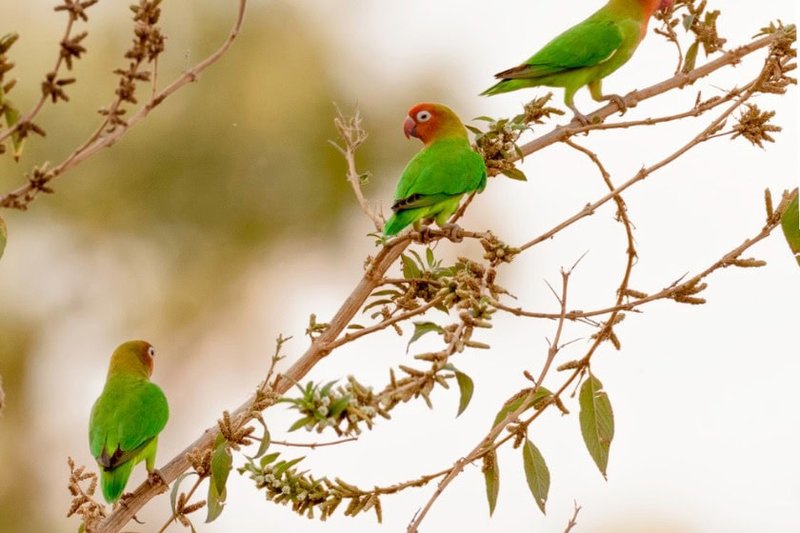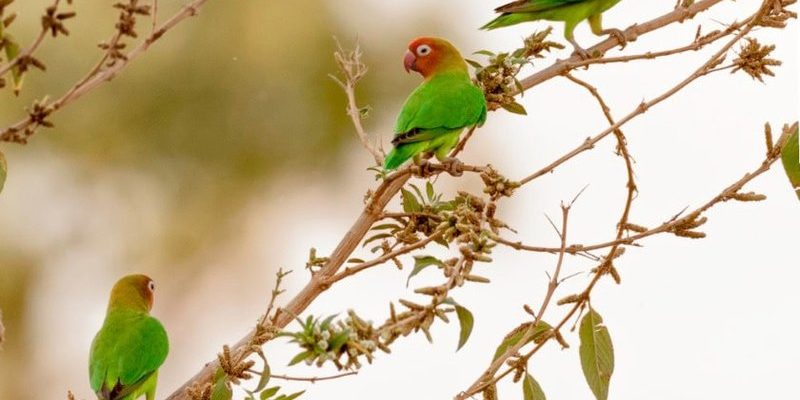
Imagine you’re on a quest to find these charming birds in the wild. Where would you go? Understanding their habitats is key to spotting lovebirds in their natural surroundings. In this article, we’ll explore the various ranges and environments lovebirds thrive in, from arid savannahs to lush forests. So, grab a cup of coffee, and let’s dive into the world of lovebirds and where to find them.
Understanding Lovebird Species
Lovebirds belong to the genus *Agapornis*, which includes several species—each with its unique traits and habitats. The most common species are the peach-faced lovebird, Fischer’s lovebird, and masked lovebird. Each species showcases different colors and personalities, making them popular among pet lovers.
For instance, the peach-faced lovebird is known for its vibrant green body and peach-colored face. They are native to the southwestern part of Africa, particularly in countries like Namibia and Botswana. On the other hand, Fischer’s lovebirds, with their striking yellow and green plumage, are found primarily in Tanzania. Each species has adapted to its specific environment, affecting their availability in the pet trade and their overall popularity.
So, when you think of lovebirds, remember that they aren’t just one type of bird—they’re a whole family, each with its own little quirks and preferences for habitat.
African Savannahs and Dry Woodlands
One of the primary habitats of lovebirds, especially the peach-faced variety, is the African savannah. These open grasslands dotted with trees create the perfect environment for lovebirds to thrive. In this habitat, lovebirds can find ample food sources, including seeds, fruits, and flowers, which are essential for their diet.
But it’s not just about food. The savannah offers plenty of hiding spots in the trees. Lovebirds are social creatures, often found in flocks. They play and communicate with each other, using their joyful chirps that can brighten anyone’s day. If you ever visit savannah regions in Southern Africa, you might just spot a flock of these lively birds flitting between the branches.
Dry woodlands are another favorite spot for lovebirds. Here, they tend to dwell in pairs or small groups, which is quite fitting given their name: lovebirds are known for their deep bonds with each other. The presence of flowering plants in these areas provides not only food but also nesting sites, making it an ideal home for raising their young.
Coastal and Riverine Areas
Spotting lovebirds isn’t just limited to dry areas. These birds can also be found in coastal and riverine habitats. For instance, the masked lovebird prefers areas near rivers and wetlands, where they can find a diverse selection of food. Wetlands are rich ecosystems, offering seeds, fruits, and even insects, which provide essential protein.
When lovebirds inhabit these regions, they often make nests in thick vegetation near water sources. This makes it easier to stay safe from predators while ensuring they have access to food and water. If you’re keen on birdwatching, consider visiting the banks of rivers or coastal regions of eastern Africa, where you can enjoy the sight of masked lovebirds dancing around the lush greenery.
The beauty of these habitats is that they support not just lovebirds but many other wildlife species, creating vibrant ecosystems. Therefore, when you’re out exploring, take a moment to appreciate the diverse life around you.
Urban Environments
Believe it or not, lovebirds have adapted to urban environments as well! With their increasing popularity as pets, some escaped or released lovebirds have made cities their home. In areas like South Africa, you might find flocks of lovebirds thriving in parks and gardens, showing that they can adjust to suburban living.
In these urban settings, lovebirds often find food sources in gardens and open spaces, where they can feast on seeds and fruits from ornamental plants. They’ve shown remarkable resilience, creating nests in trees lining streets or even in gardens, much to the delight of local birdwatchers.
If you live near a city, keep your eyes peeled in parks or large gardens. You might just catch a glimpse of these cheerful little birds, adding a splash of color to your day.
Conservation Areas and Reserves
Many lovebird species are at risk due to habitat destruction and the pet trade. Thankfully, there are conservation areas and reserves dedicated to protecting these charming creatures. In places like the Kruger National Park in South Africa, lovebirds can thrive in their natural settings, shielded from threats.
Visiting these reserves not only gives you a chance to see lovebirds in their natural habitat but also supports conservation efforts. In these protected areas, lovebirds and other wildlife can live freely while researchers study their behavior and reproduction. It’s a win-win—birdwatchers get to enjoy nature’s beauty, and conservationists can work to ensure these species continue to thrive.
When you plan your trip, consider visiting these reserves, where the stunning landscapes and vibrant wildlife create an unforgettable experience.
Cultural Significance of Lovebirds
Beyond their habitats, lovebirds hold cultural significance in various societies. In many African cultures, lovebirds symbolize love and fidelity due to their strong pair bonds. You might find them depicted in art and folklore, often representing happiness and companionship.
In some regions, lovebirds are even considered good luck. People often gift them to newlyweds or couples to signify a thriving relationship. This cultural attachment adds another layer to their appeal, inspiring both admiration in their beauty and respect for their role in human traditions.
Understanding this significance helps us appreciate lovebirds beyond their physical presence. It connects us to the stories and emotions tied to these delightful birds.
How to Spot Lovebirds in the Wild
If you’re eager to try spotting lovebirds, here are some handy tips:
- Early Morning is Key: Lovebirds are most active during the early hours of the day. Head out at dawn for your best chances.
- Listen for Their Calls: Pay attention to their cheerful chirps; these sounds can lead you to a flock.
- Look Upward: Since they love to perch in trees, scanning the branches will help you spot them.
- Be Patient: Sometimes, it takes a little while, but staying quiet and still increases your chances of seeing them.
With a bit of luck, you’ll witness their playful interactions and vibrant colors up close. Just remember to respect their space—after all, they’re wild creatures enjoying their natural habitat.
In conclusion, lovebirds are not just some of the most endearing pets; they represent a rich tapestry of habitats and cultural significance around the world. Whether in the savannahs of Africa, a bustling city park, or a protected reserve, these birds offer a glimpse into the beauty of nature and the bonds we cherish. So, when you’re next out exploring, keep an eye out for these feathered symbols of love!

